Note:
If you follow my husband, you’ve probably seen already that we’re expecting our first child. I’ve passed the half way mark and am enjoying the wonderful sensation of feeling the baby flutter on occasion like a little butterfly. It’s been a wonderful pregnancy with mild nausea. I walk a lot, nap a lot, eat well, and drink a decent amount of red leaf raspberry tea mixed with nettles.
I apologize for giving you all two controversial essays in a row! I’m afraid everything I have scheduled for next month is more of the same stuff. I’m not doing a lot of writing currently, but I promise you I have some tamer articles brewing at the back of my mind. Meanwhile, I hope nothing I am posting will cause offense. Everything I share is meant only to share an alternative perspective and to allow you to share a bit into how I think and believe on these matters. At the end of the day I’m too busy trying to remove the log from my own eye to notice or care what any of you all are doing or wearing.
Aside from all that, a few readers have asked if we did a registry. At first I said no. However, I know how much I enjoy giving gifts to friends and strangers alike, so I cobbled something together for the more persistent ones among you so you might peruse it. Thank you for your prayers, support, and kind words.
I hope you enjoy this essay even if you disagree with its entirety!
Before I married, I was a seamstress at a formal-wear business. I worked on all sorts of items from mending bath towels to adjusting wedding dresses. Even though I was the only conservative Christian, I loved my workplace. I felt respected, I took pleasure in my work, and I developed deep friendships with my co-workers. Our employer encouraged us to only take on projects that we wanted to do. It was one of the healthiest environments I could’ve dream for working.
One day a man walked in asking for an alteration. Usually I didn’t interact with customers until it was time to pin their garments, but everyone else was on lunch-break.
“Can you help me?” the man asked, sounding strangely anxious.
I had a funny feeling at the bottom of my stomach, but I said, “Yes! What would you like?”
“I need this dress taken in.” He shook a little as he said this, not looking me in the eye.
My heart dropped to the bottom of the floor. I knew I could turn him away and my boss wouldn’t be angry with me. I thought back to that story of the bakery that was sued for not making a wedding cake for a gay couple. I knew that this man didn’t have the wits or wherewithal for pressing charges. There was nothing to worry about. I didn’t have to help him. I didn’t want to. But I couldn’t bring myself to be rude. I couldn’t bring myself to lie and say I didn’t have any openings.
I told him to go to the dressing room and put the dress on, praying that a co-worker would return and take over the fitting. Nobody showed up.
The man was nervous and sweating profusely as I pinned him. I tried to hold my breath without seeming mean. I took in fabric from under his arms, and then from around his “hips”. I tried to touch only the dress and not the man. I tried to squeeze my eyes shut without poking him with a pin. I hurried as fast as I could, trying not to feel repulsed, feeling horrid that I felt anything mean toward this poor man. I didn’t want to feel how I was feeling. This man wasn’t forcing me to do anything. And then I felt angry. Angry that a woman like me was subjected to live in this society.
I finished the pinning, and the man thanked me with enthusiasm. Normally I’d have put an alteration at the end of my queue, but I altered the dress as soon as he left. I didn’t want to have to think about it anymore.
As I altered the dress to fit the man, I thought how strange it was that although I was a woman who always wore dresses, I never felt this same level of repulsion when a woman wanted me to alter anything for her. I’d hemmed slutty dresses even shorter, and had altered men’s pants to fit women. “Was this how traditional seamstresses felt when they were first confronted by a woman who wanted a pair of slacks altered?” Personally I disapproved of women wearing pants, but I was never troubled while altering them for women.
So why had altering this dress bothered me so much?
Honestly, I didn’t let the question sit with me for long. I was so disturbed that I chose to forget about the whole incident.
It’s very easy to have a worldview that is validated by the bubble that informed your worldview. It’s even easier to have beliefs about other worldviews without ever stepping into their bubbles. I find this is common no matter if you’re brought up religious or secular, liberal or conservative, and I’ve always been bothered by this. I don’t want to see an end to “bubbles”, but from a young age I was interested in understanding why others believed and thought and lived as they do.
A few months after the dress incident I took five months off to travel, and found myself visiting extremely liberal “woke” communities. I was a work-study at a folk school for six weeks, and while I was there I interacted with dozens of people who were nothing like me, although I chose not to let on and observe their behavior and life. Before that I’d attended a week-long contra-dance — again mostly liberals, and before that I’d gone to a lot of old-time music bars to dance.
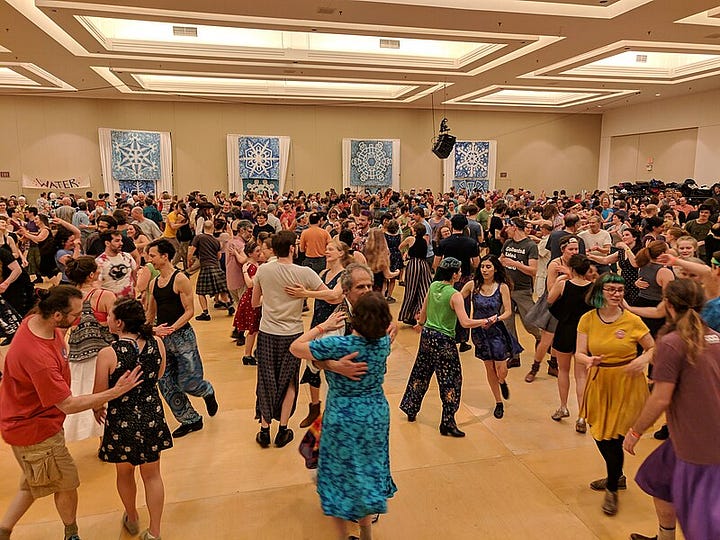
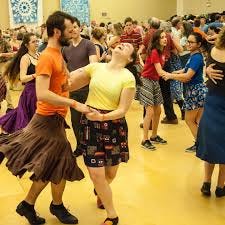
I saw men in dresses, and ended up talking or dancing with many of them. While some of them were homosexual, I was surprised to discover that quite a few of them were completely straight and attracted exclusively to biological women. These men all wore similar a-line dresses with floral patterns and twirly skirts. They wanted to embrace their “feminine” nature while still being masculine as they danced. Most of them weren’t pretending to be women. Perhaps they liked the feel of the skirt swooshing as they spun. Perhaps they wanted to be shocking. Nobody really talked about it — it was supposed to be a safe space no matter how you identified. Occasionally, I heard explanations like, “I want to break gender expecations” or “women wear pants, why shouldn’t I wear a dress?”
I’m Facebook friends with one man who mostly only posts pictures of himself in princess ball-gown dresses. I know very little else about him except for dancing in obsession with gorgeous dresses.
These men are not easy to put into a box. Some were obviously gay. Others were merely toying with the idea of gender-fashion. I found myself crushing on one of these men despite the pink, sparkly polka-dot dress he wore as we danced.
At some point, if you’re dancing with someone of the opposite gender a lot, and the dancing is good, the clothes they wear become inevitably irrelevant.
As I said, I never made a huge deal out of the fact that I was a conservative Christian. It became slowly obvious though over time, and friends would ask me about myself, and then I’d keep it no secret. “You’re a christian? But you seem so nice,” they’d always say, in surprise. When they asked me what I thought of things, I’d tell them honestly. While I was surprised that they weren’t offended, I think they were even more surprised that they weren’t.
At some point, someone noticed that I never wore pants, and I was asked to give an answer.
Without really thinking about it, I said, “I believe women should dress like ladies, and men like gentlemen.”
My liberal friends — who believed fashion must be liberated from gender norms — nodded. “We can respect that.” And certain of my new friends even started dressing more in the bounds of their gender after that. My female friends especially took to wearing dresses with me more often, telling me how admirable they found it that I could be so utterly feminine even while I gardened or skinned roadkill just as when I danced.
Conservatism is a strange political ideology. Although immersed in this culture since I was a child, I don’t know that I understand it completely. It’s the party that conserves, although I’m not sure there’s much intentionality put into what it conserves aside from an attempt to retain normalcy as it is currently perceived.
Conservatism isn’t really about safeguarding tradition or truth, but seems to me to be more of an ideology of relativism. It does not believe that virtue is timeless or absolute. It is the act of drawing a line in the sand. When liberals manage to “wash” that line away, Conservatives will “redraw” that line wherever it feels the least painful. Although certain of my members have rebelled against the “redrawing” of the lines, I am still a result of “conservatism”. I have no problem altering pants for women, however if I were born a hundred years ago, I would.
The Amish are a great example of conservatives who arbitrarily draw lines and stick to those lines above all else, except their lines were drawn in the 17th and 18th centuries and they’ve done pretty well at not letting the tides of culture wash away their lines.
I believe that if things go on as they are, unless the progress of modernity is somehow derailed, that in about seventy years time it will be socially normal for men to wear dresses including conservative Christian men.
Christian Conservatives seem to be barely aware that this is a possibility, and that’s mostly because they only read the news and rarely interact with any real liberals. Furthermore Christian Conservatives don’t understand why it will happen. They have a conflated view of what it means to cross-dress. They wouldn’t tell you that cross-dressing is something only men can do, but if you asked most of them what it looks like for a woman to cross-dress they would say, “I don’t know.” Or they might make vague references about drag.
However conservatives fear that men wearing dresses could become a predominant culture fixture, at least for an interim. The rate of Christian Conservatives choosing to home-school is rising as they consider the potentiality that their kids might be indoctrinated by teachers with pronouns or men in dresses. Even non-christian Conservatives are falling over themselves to make sure their kids are not overly exposed to men in dresses. Yet they — we — are in a bubble, and we’re all unable to see that the things we fear are mild symptoms of something we’ve already accepted.
After all, just how long have women been permitted to wear pants?
The US Attorney General announced in 1923 that it was now legal for women to wear pants. However, it was still effectively illegal for women to wear pants in many settings. Without Hollywood actresses like Katherine Hepburn and feminists of the ilk of Hilary Clinton making a fuss about a woman's right to wear what she wants, women might not have ever started wearing pants. The 50s were the decade of the trad housewife, but also of bikinis, and insurgence of porn consumption, and of women vying for a place in a man’s world. It began to become standard for certain women to wear pants, and yet most states didn’t declare that a woman had the right to wear whatever she pleased to work until the 1970s. Following that, the White House also began permitting women to wear pants. However, not a single woman dared pose for an official Whitehouse portrait until Hilary Clinton paved the way in 2004.
Elizabeth Cady Stanton, a suffragette and feminist said, “The question is no longer how do you look, but woman, how do you feel?"
However, Stanton was not talking of the fitted jeans with studded jewels on her back-pockets, but of blousy bloomers that a few “extremist” feminist chose to wear under knee-length skirts. This was at the turn of the 20th century.
Nevertheless, one could presume that Elizabeth Cady Stanton might’ve been wearing pantsuits right alongside Hilary Clinton had she lived just another fifty years. Her words, too, sound eerily identical to the words of modern liberals who talk about gender being a matter of your feelings. Instead of letting fashion cage you into a specific way of being, it can be a tool to better express what you’re feeling inside.
G. K. Chesterton had something to say about this. “As a little while ago it was common for an “advanced” woman to claim the right to wear trousers; a right about as grotesque as the right to wear a false nose…”.
Chesterton was just one of the many who opposed women wearing pants, but not because he thought of pants as some immodest garment that might arouse a man to lust. He didn’t seem to ever imply that he thought that women who wore pants were immoral, but rather that pants in and of themselves were an abomination of the modern era, and that even though men were now subjected to the vulgarities of this fashion, women were of a greater innate dignity. He held women on a pedestal, and any grotesque act committed by women was more terrible than if a man had done it, for the inspiration of beauty had been squelched.
In his book about Saint Francis, Chesterton writes, “The modern innovation which has substituted journalism for history, or for that tradition that is the gossip of history, has had at least one definite effect. It has insured that everybody should hear only the end of every story.”
It’s around this point of the essay that readers might start to point to other cultures, “Well, women wore pants in Asia or no clothes at all in Africa, and men used to wear robes in ancient Israel, so God doesn’t really care what we wear and cross-dressing is relative to the current cultural idea of it, and that’s it.”
I do not believe there’s any merit discussing the customs or fashions of Asia, of tribal peoples, or of any non Christian peoples. These various tribes also sacrificed their babies on alters and denied the existence of God — why would I look to them on how a Christian woman ought to dress? These people had a different ethos than Christians. If these people had morals, they were often viewed to be foreign or incompatible with Christian ethics. A Western philosopher or theologian might look to these people to add or expand his own wisdom, but he would never base his own arguments on theirs, nor justify his beliefs with the superstitions of “barbaric” e.g. unchristian peoples.
If I want to understand Asian culture, I will study the fashions and customs of the Asians, and copy their practices. If I want to imitate the traditions of an African woman, I will look to African women, not to Japanese or Scottish or Serbian. However, if I want to cultivate a better walk with Christ, I will look to the lives of the Christian saints and emulate no others but them.
It is very easy to claim that feminist ideals or degenerate fashion trends are alone responsible for the normalization of women’s pants. It is also easy to say that men and women who opposed a woman's right to wear what she wants were quaint and archaic. However, in order to fully understand why women were prohibited from wearing pants for centuries, it is important to understand the history of pants, and why men began to wear them at all.
In doing this we will be able to see why women’s pants is not at all equatable to men’s robes. There is no gender-neutral clothing.
Christianity became the official religion of Rome in 380 BC, only three years after pants were illegalized for men to wear (it was still not a question for civilized women). Before this, Roman soldiers would wear wool pants when at war with pagan tribes in northern climates. Some of the regular citizens took to wearing pants for aesthetic purposes, however the Roman Emperors disapproved. They forbade male citizens from wearing pants, boots, and jewels, and from having long hair so that they would not look as the pagans did. Pants were associated with the military, with conquering, and with the conquered — especially with the Germanic tribes who would kill their criminals through a ritualistic custom of sinking them in bog. Pants were considered crude because they were worn by uncivilized peoples or during times of war. Additionally, Rome was trying to preserve its own culture in a time when people were becoming easily infatuated with the customs of the nations they conquered.
Over the course of several centuries, pants became an accepted part of a man’s wardrobe although they retained vulgar connotations. This is why Chesterton would write that he found the whole idea of pants an abomination, but that women should at the very least be spared the indignity of wearing them.
In 866, Prince Boris was thinking of making Christianity the religion of his nation, and so he sent a list with a considerable number of questions to Pope Nicholas I. The Pope’s letter of response is not considered a religious document, nonetheless one of the answers he offers is of interest because it deals with whether or not women should wear pants:
But since you ask concerning these matters in your simplicity, namely because you were afraid lest it be held against you as a sin, if you diverge in the slightest way from the custom of other Christians, and lest we seem to take anything away from your desire, we declare that in our books, pants (femoralia) are ordered to be made, not in order that women may use them, but that men may. But act now so that, just as you passed from the old to the new man, [cf. Eph. 4:22-24; Col. 3:9-10] you pass from your prior custom to ours in all things; but really do what you please. For whether you or your women wear or do not wear pants (femoralia) neither impedes your salvation nor leads to any increase of your virtue.
This text is often misconstrued as an argument that the Pope approved of women wearing whatever they wished. This is an unjust simplification.
At the start, the Pope encourages that pants be manufactured exclusively for men, But then he allows that it is not a salvational issue — he wasn’t going to let this one issue keep all of Bulgaria from becoming Christian! And I agree with him. There will be Saints in heaven who wore pants on Earth, for the mercy of God is so good that he does not require any of us to be perfect in order for Him to perfect us.
However, there’s no historical proof that the Bulgarian women were wearing pants at such a date as 866. It’s unclear what garment was discussed in this letter. It could've been underwear or armor for all we know. And yet, it does beg the question. Is it a sin for a man to wear a dress, or for a woman to wear pants? Is there such a thing as gendered clothing, or are the liberals right to lead all of us into a complete gender liberation?
I recently googled “men in dresses” and these headlines were at the top of the page:
“Is Dresses for Men the New Trend? Breaking the Boundaries and Stereotypes of Gender with Fashion”
“Skirts & Floofy Dresses: A Referendum on Masculinity”
“I Feel More Like a Man While Wearing a Dress Than I Ever Did in a Suit: In the end, it’s the same you, just a different piece of fabric."



A few snippets from these articles read just the same as early articles about women fighting for the right to wear pants. “Men have always worn dresses. In some cultures, people fail to realize that there is nothing wrong with men in dresses. Many influential people have come forward to break the stigma so men can wear whatever makes them happy.”
“It’s a myth that ‘dressing like a woman’ prevents men from being ‘manly men’”.
In the third essay the author, Philip Ellis, sews his own clothes, and talks about how he rediscovered his masculinity through making his own dresses. He writes, “Like so many of us recently, I've been reflecting on what I think it means to be a man. It bothered me that I would not think twice about seeing a woman in a suit, but somehow the idea of a man in a skirt was just not done. I think many men can relate to this. It's a principle that applies to many gendered traits and habits. If it’s OK for a woman to take on "masculine" attributes, but a man with so-called "feminine" qualities is socially unacceptable, that creates this subtle notion that men are socially more desirable or worthy than women. None of us actively wants to send that message, but it’s there nonetheless.”
These men have no more intentions to “cross-dress” than women who wear pants.
Cross-dressing, though, has never been defined by intentions. It is a specific thing. Wiki describes it as, “Cross-dressing is the act of wearing clothes traditionally or stereotypically associated with a different gender. From as early as pre-modern history, cross-dressing has been practiced in order to disguise, comfort, entertain, and express oneself.”
A recent article on cross-dressing I came across states, in summary, that cross-dressing can be as simple or elaborate as you like from wearing a pair of panties or tie, to a full face of makeup and outfit that is associated with the opposite gender. It can be done for drag, or it can be done to make yourself feel however you want to feel. It can be for comfort and practicality if that’s your intention.
A better phrase for cross-dressing, though, is gender liberation.
Women have been liberated from their gender to wear whatever they want without fear of being accused of being homosexual. Men are not fighting to have their gender freed in the same fashion.
“The woman shall not wear that which pertaineth unto a man, neither shall a man put on a woman's garment: for all that do so are abomination unto the Lord thy God.”
- Deuteronomy 22:5
It’s very easy to take a single verse and build a doctrine out of it. However, this verse has arguably done more than that — it has dictated the fashion of men and women for many thousands of years, and it’s done so without any explanation or description of what it means to “wear that which pertaineth unto a man” or “to put on a woman’s garment”.
And since the Bible gives us no guidance on how to not become an “abomination unto the Lord”, we’ve had to trust the decrees of Governments and fads “cultural norms” to direct us.
We know that in the Bible there was a distinct way in which men and women dressed. It was possible for a woman to dress like a man, and vice versa, even though there were no such things as pants then. We also know that God cared much more about the spirit of the law than his actual decrees, and that His laws weren’t designed for our ruin but for our perfection.
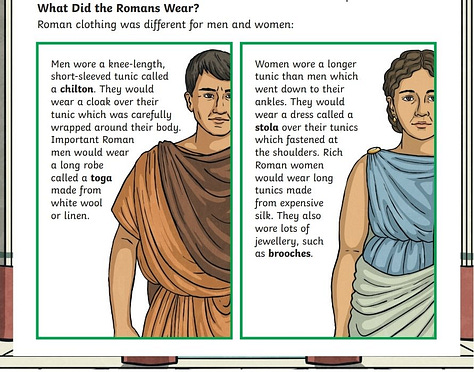

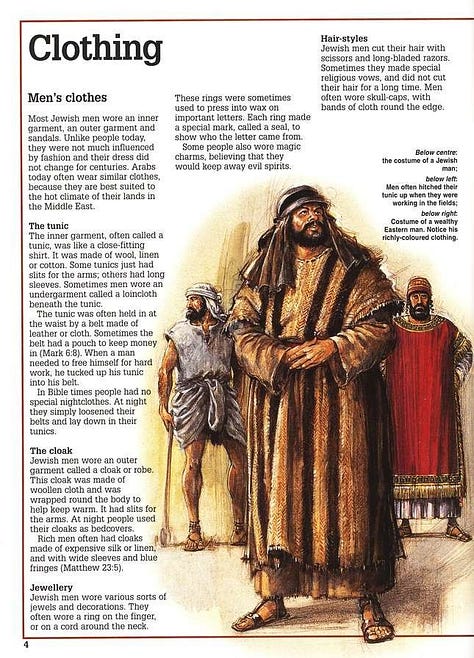
However, I think it’s fair to say it’s not exclusively about the clothes you wear as much as what’s in your heart. Pope Nicholas I said just this, as did G. K. Chesterton.
Two of the most controversial but devout Religious women I can think of dressed like men: Deborah, who was the only woman to wear the Biblical colors of judges and priests, Saint Joan of Arc, who put on a suit of armor and went to battle. And yet what these women had in common wasn’t that they wore the clothes of men. They were not women concerned with “women’s issues”, or with their rights, but were selfless women called by God to do a man’s work when no man listened to the voice of God. They both were instruments of Heaven used to humiliate men who had forgotten their masculinity.

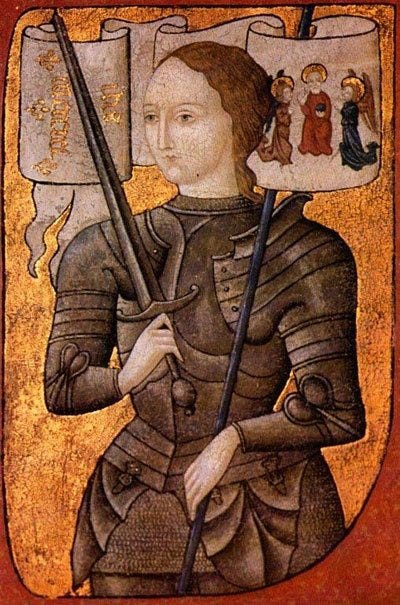
A woman is not acting immoral when she is being forced to the work of a man, but the innocence of her nature is sacrificed, therefore this undertaking should be extremely rare.
It is each woman’s vocation to spread beauty. When she is forced to become like a man, she kills her own flesh. If this sacrifice is made with no benefit to humanity, and the masculinity of men continues to disintegrate, the sacrifice is made vainly, and becomes perverse. Without a just cause, the sacrifice of a woman’s femininity becomes an abomination to the Lord.
One can argue that feminism started out as a just sacrifice of the female sex for the masculine, and that somewhere along the lines the sacrifice soured and turned perverse. One could argue that there were necessary sacrifices of women’s femininity for men during the industrial age and during WWII on a national level. However, these sacrifices were not meant to continue on as they have. Women were not meant to be erased for the sake of men as children slaughtered for Molech. At some point, there should’ve been a reckoning and a return to balance between the sexes.
It is both women and men who will have to give an account. Clothes are merely a symbol of this perverse sacrifice, though. Women can no longer cross-dress for the man’s wardrobe is fully their own, too. However, although robes once belonged to both men and women, men are not permitted to wear what is in their wife’s closet. To go above the conversation of fashion: We have books, podcasts, and blogs dedicated to “women’s issues”. We have no such equivalent for “men’s issues”; the redpill bros are no substitute. Both women and men are now permitted into bars, horse races, casinos, etc. There exist women-only salons, baby showers, and friend groups. However, there are no men-only spaces and events, except for perhaps the man-cave, but that is a lonely, de-humanizing allowance made for men. Women have elbowed their way into preaching and politicking. Men who try to be stay-at-home fathers are ridiculed and distrusted. The only exception I can think of is that among certain Anabaptist groups men still very much have their own domain separate from the women — but then it is also still possible for their women to cross-dress if she tried.
The most tragic thing about women filling men’s roles and assuming men’s responsibilities is that men have been stripped of being anything other than the default neutral gender.
Even domestic arts have morphed to reflect the false notion that anything masculine is base-line and anything feminine is frivolous and a nuisance. This idea is offensive to both sexes. Too busy in the kitchen? Why bother? Pants. Playing with children on the floor or outside in the sand-pile? Sure, women have always done it, but men’s clothes are better suited even for feminine pursuits. Want to look sexy for a late night out? Tight pants. It’s cold? Pants. It’s hot? Pants. Feeling sweaty? Pants. Not feeling girly? Pants. Feeling tomboyish? Pants. Feeling invisible? Pants.
Yes, both men and women used to do all these things in robes (or dresses). And I imagine they would laugh at us a little. Why do we feel like we’re so much more empowered because of our pants? We’ve lost touch with reality — why not slow down in the rush of things and and enjoy the feeling of sand or wood under our bare legs as our children play, the feeling of mystique as men see us enter the room, the feeling of the first frost or the first drops of perspiration, the feeling of what it means to be womanly, the feeling of being strong and tough despite what we’re wearing, the feeling of God’s eyes always upon us.
Pants and dresses have turned into a mere symbol of a failed dynamic between men and women. Jeans especially have become the great homogenizer of both sexes and all cultures. If Rome had known that it all might lead to this, they might have tried a little harder to keep people from ever wearing these “barbaric” garments. Not only are they unflattering, they are dull and crude and underwhelming. They do not get the job done better at all, but they do make everything about the job.
Life is about more than being a tool or industry and politics.
I’ve flippantly posted on twitter that wearing pants is gay. I think it’s much more complicated than that. Pants represent something that is barbaric, ugly, and war-like. Pants prioritize function over vulnerability, which often leads to the assumption that beauty is impractical.
I think this is what I most detest about pants.
Saint Padre Pio had a reputation for turning people out of his church if they were improperly dressed. If a man or boy came in with shorts or Capris or short sleeves they were sent home. If a woman entered in a mini skirt he would tell her to leave. There is a disputed story that once a seamstress entered his confessional and asked for absolution. He refused, and instead told her to return to her shop.
“Get rid of all the trousers you’ve made for women — and do not donate them to any woman!”
This Saint especially detested women’s pants, but not for the reason one might assume. He was not misogynist. He turned away more men than he did women for indecent dress. He was a Saint who could see past the clothes into the heart. If a woman came in wearing a long skirt having heard about how he turned away those who would wear a mini skirt, he’d call her out on it.
“Do not think you can deceive me,” he would say. “I see how you are dressed now, and how you will change when you return home.”
He would see priests who he had never met in everyday clothes, and say, “Why are you not in your habit?”
He could see the heart, and he was not impressed with how it was dressing itself outwardly. He spoke often about dressing properly.
“There are, moreover, three virtues which perfect the devout person with regard to control of his own senses. These are: modesty, continence and chastity. By the virtue of modesty the devout person governs all his exterior acts. With good reason, then, does St. Paul recommend this virtue to all and declare how necessary it is and as if this were not enough he considers that this virtue should be obvious to all. By continence the soul exercises restraint over all the senses: sight, touch, taste, smell and hearing. By chastity, a virtue which ennobles our nature and makes it similar to that of the Angels, we suppress our sensuality and detach it from forbidden pleasures. This is the magnificent picture of Christian perfection. Happy the one who possesses all these fine virtues, all of them fruits of the Holy Spirit who dwells within him. Such a soul has nothing to fear and will shine in the world as the sun in the heavens.”
I do not want to confuse the reader into equating wearing trousers with modest dress. This is not a conversation about modesty. A woman can be either modest or immodest in pants just as she can in a dress depending on a number of factors.
Rather I want to remind women to let men be men. Maybe we can do better at being like men than they can — but they’ll never be as good as us at being women. There comes a point where we have to hand the reins back to them and take care of the squalling children in the back of the wagon. I am discussing the idea that a woman has the right or duty to abandon her own responsibilities so that she might assume a position in a man’s world, and to wear his clothes indefinitely.
Such a thing is her prerogative when she is directly called to do so by God.
But whenever she obeys in such a manner, it is to the shame of men, for it infers that the men in her life were not living as they should. If however a woman is brought up in a culture where women continue to live in a man’s world because their mothers or grandmothers were forced into it, that woman ought to return to her own responsibilities and allow men the space to be men again. And to presume that it is impossible for a woman to be a woman in her own clothes is preposterous — perhaps it takes skill to dress like a lady, but a skilled woman is empowered not hindered by her femininity.
Most of us are not St. Joan of Arc or Deborah — two women so rare they were separated by several thousand years!
Most women will never receive a vision from God in which they are told to become like a man and go to war. There will be women who say “The Holy Spirit told me to wear pants” or “the Holy Spirit directed me to join the military”, but very few of them will be telling the truth.
I am not saying that we can change much in this world culturally. What has become normal is normal be it found in Eden or Sodom and Gomorrah or in American and Europe. Liberals will continue to do their best to liberate us all from our gender expectations, and conservatives will follow slowly behind. Women will continue to wear pants. Steadily men will wear dresses more often, too. Women will do all the things they want, and men will start to pick up the slack.
Those of us who are willing can try to exemplify something transcendental despite what is or will become normal. We mustn’t be ruled by current fashions and customs if we want to be Pilgrims on earth. If that’s our only metric for Truth we’ll find ourselves in some questionable clothes . . . but don’t worry! Eventually it won’t be questionable anymore! Everything eventually becomes normal if the majority of culture accepts it as so!
“Why do women want to dress like men when they’re fortunate enough to be women? Why lose femininity, which is one of our greatest charms? We get more accomplished by being charming than we would be flaunting around in pants and smoking. I’m very fond of men. I think they are wonderful creatures. I love them dearly. But I don’t want to look like one. When women gave up their long skirts, they made a grave error…”
~ Tasha Tudor
Conclusion
The history of pants isn’t really as complicated as we want to make it out to be, however I think it’s a little inexact to surmise that pants are merely masculine coded. While they were a piece of clothing created for men, they were explicitly a garment of war. They are a metaphor for bloodshed, and in a perfect world, men, too would not wear them.
As Chesterton and many others pointed out, pants dignify neither man nor woman. They are barbaric. If anything, pants represent the shame of humanity and it’s blood-thirst to kill and murder. Without war there is no true necessary purpose for pants — every other task is possible if one possesses grace and skill1.
It is beauty that inspires, and it is beauty that gives life. This is why women especially should be separated from anything warlike. Not only should women not be men, they are meant to be the ones who nourish and sustain life.
It is misleading to believe that our clothes have little to say about our spirit and soul, when it is our spirit and soul that shape and govern our wardrobe.
When I was eleven or twelve my grandfather brought two hitchhikers home — a woman and a man. They each wore a robe, she in red and he in black, to represent the end of times, they said. I was drawn to them, as I am now drawn to priests and the Twelve Tribes and any such group that rejects conventional gendered fashion. Ironically these sorts of people are often pacifists, too.
To most Conservatives, masculinity is the default gender while femininity is the baseline to most Liberals. Such an extreme lack of dichotomies has created watered down gender norms that lack oomph. There is no marriage and therefore transcendence of the sexes in the world of polarized politics.
“There is neither male nor female. 2” We are made in the image of God who has no gender and is at the same time both feminine and masculine. This is one of the greatest mysteries about God, and about ourselves, and we see it expressed in Jesus who although fully man was also fully God and therefore not man.
There is something honest and real about how woke scenes and cults try to remove gender from fashion. The only pure comparison we see is in monasteries and convents, which aim to emulate the image of the Trinity as perfectly as is humanly possible.
An earthly utopia is unlikely, but I would much prefer to live in a world where there is no more war, and therefore no more pants. Yet I feel certain that there shall be no pants in paradise.
After these things I looked, and behold, a great multitude which no one could number, of all nations, tribes, peoples, and tongues, standing before the throne and before the Lamb, clothed with white robes, with palm branches in their hands, and crying out with a loud voice, saying, “Salvation belongs to our God who sits on the throne, and to the Lamb!”
~ Revelation 7: 9-10
Thank you for reading Polite Company. My publication is free to readers, but if you’d like to support my writing and handiwork endeavors you may Buy Me a Coffee.
I will soon write a practical guide on how to can dresses in any situation without hindrance
Galatians 3:28






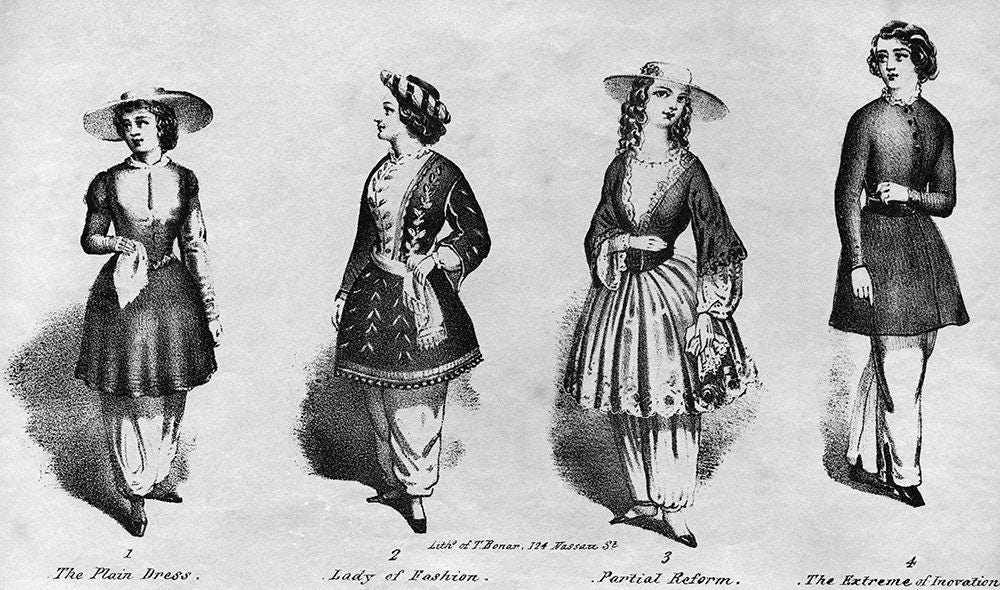
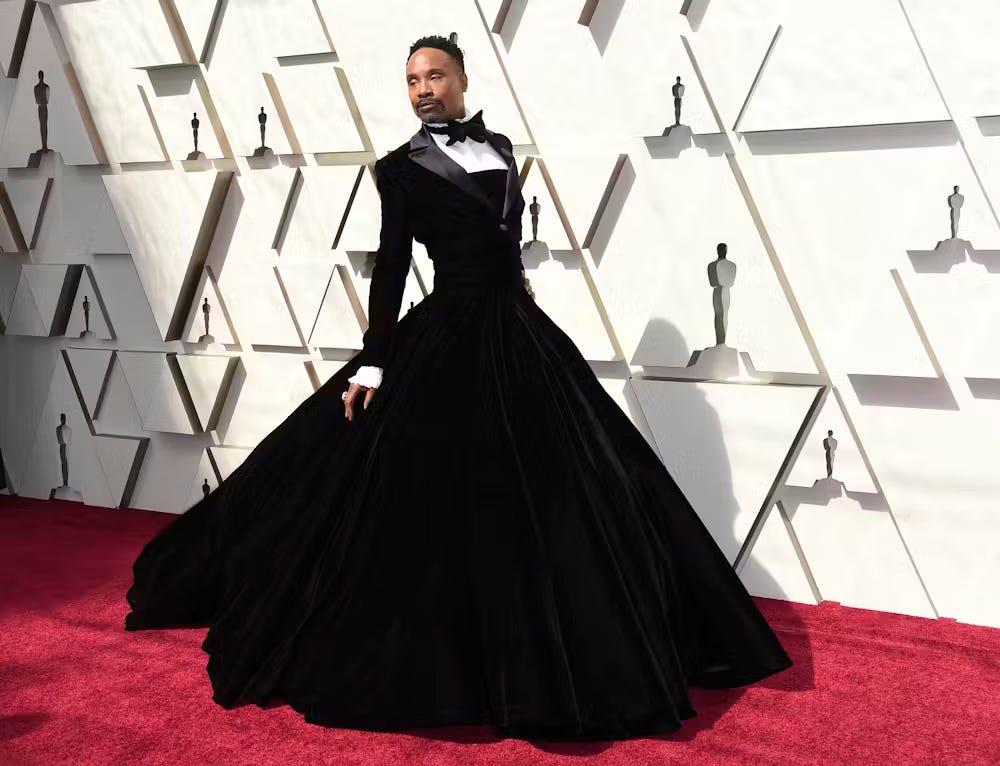



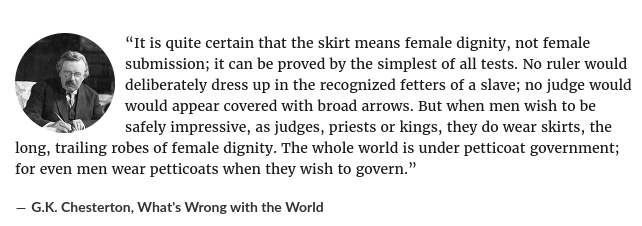
Dear Keturah, I read this article with great curiosity and interest a few months back. I grew up in a liberal, atheist, European family so naturally, no one ever discussed whether pants or dresses were appropriate for women. These topics were not even on my radar. If anything, I wear pants most of the time out of habit. When I lived in an African country however, I wore dresses most of the time because its really hot and all women there wear dresses and skirts most of the time. I was not even allowed inside a public building if I wore pants or open-toe sandals, to my great surprise !
After pregnancy and the many changes my body went through, I started to have problems with pants. There are too tight, unconfortable, do not adjust to the ebbs and flows of my waist and my belly. But still, I didn't really consciously allowed myself to mostly wear skirts. I wore those horrible leggings or out of shape pants for months, looking shaby and feeling embarassed at my appearance.
After reading your article, it kinda brewed in my mind over a few weeks..... so I gave it a go. Found a beautiful skirt at a second hand shop and I just love it: it is so confortable, so freeing to not be ensnared in tight pants.... I got myself a couple more here and there and have been trying to be more intentionnal in how I dress. Just a very interesting development all around so I wanted to give you a feedback :) have a great day
This is very interesting.
The robe itself - very plain - is by itself a fairly androgynous garment, in many ways because it hides and obscures the human form. But when it develops, and conforms more to the skin, it takes on the attributes of that body which lies beneath it. A monk's cord begins to show (or not show) their hips. The aspects of a dress begin to accentuate a woman's hips and breasts. A bishop's vestments, layered on, have a gravitas that only makes sense in the masculine, and would be betrayed by feminine curves.
That there is a more elegant form of clothing for both men and women does not demolish the idea that it would not develop into different things for both sexes.